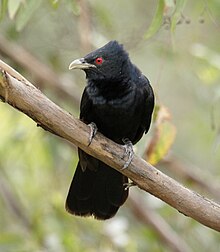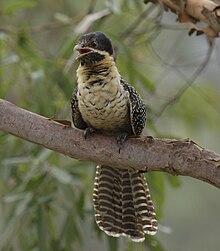| Pacific koel | |
|---|---|

| |
| Male | |

| |
| Female | |
| Conservation status | |
 Least Concern (IUCN 3.1) | |
| Scientific classification | |
| Domain: | Eukaryota |
| Kingdom: | Animalia |
| Phylum: | Chordata |
| Class: | Aves |
| Order: | Cuculiformes |
| Family: | Cuculidae |
| Genus: | Eudynamys |
| Species: | E. orientalis |
| Binomial name | |
| Eudynamys orientalis (Linnaeus, 1766) | |

| |
| Distribution of the Pacific koel in turquoise (also outside the map in southeast Australia) | |
| Synonyms | |
|
Cuculus orientalis Linnaeus, 1766 | |
The Pacific koel (Eudynamys orientalis), also known as the eastern koel or formerly common koel, is a species of cuckoo in the family Cuculidae. In Australia, it is colloquially known as the rainbird or stormbird, as its call is usually more prevalent before or during stormy weather.
Taxonomy
The Pacific koel was formally described by the Swedish naturalist Carl Linnaeus in 1766 in the twelfth edition of his Systema Naturae. He placed it with the cuckoos in the genus Cuculus and coined the binomial name Cuculus orientalis. Linnaeus based his account on the "Le Coucou noir des Indes" that had been described and illustrated in 1760 by the French zoologist Mathurin Jacques Brisson in his multi-volume work Ornithologie. The type locality is Ambon Island, one of the Maluku Islands of Indonesia. The Pacific koel is now placed in the genus Eudynamys that was introduced in 1827 by the naturalists Nicholas Vigors and Thomas Horsfield. It was formerly considered to be conspecific with the Asian koel (Eudynamys scolopaceus) and the black-billed koel (Eudynamys melanorhynchus).
Eight subspecies are recognised:
- E. o. orientalis (Linnaeus, 1766) – central Moluccas
- E. o. picatus Müller, S, 1843 – Sumba to Timor (Lesser Sunda Islands) and south Moluccas
- E. o. rufiventer (Lesson, RP, 1830) – New Guinea and west, north satellites (includes minimus)
- E. o. hybrida Diamond, 2002 – Crown, Long and Tolokiwa (west of New Britain) and Credner Islands (east of New Britain, southeast Bismarck Archipelago)
- E. o. salvadorii Hartert, EJO, 1900 – New Ireland, New Britain and satellites (east Bismarck Archipelago)
- E. o. alberti Rothschild & Hartert, EJO, 1907 – Buka to Makira group (Solomon Islands)
- E. o. cyanocephalus (Latham, 1801) – central east Queensland to south New South Wales (central east, southeast Australia)
- E. o. subcyanocephalus Mathews, 1912 – northeast Western Australia to central east Queensland (north Australia)
Description
The Pacific Koel can be identified by its black plumage, often tinted with blue and green, and red eyes. The species is sexually dimorphic: the female has brown plumage along the back with white spots and the underbelly is often cream coloured with fine black stripes. Young birds resemble the female but have dark eyes.
Distribution and habitat
It is found in forest, woodland, plantations and gardens from Wallacea east to the Solomon Islands and south to northern and eastern Australia. The Pacific koel has not been rated by IUCN, but the Australian Koel (here included in the Pacific koel) is considered to be of Least Concern.
Behaviours
The Pacific koel is a brood parasite. In Australia, their hosts are mainly large honeyeaters (especially noisy friarbirds and red wattlebirds). Unlike in other parasitic cuckoos, the young do not attempt to kill the host chicks. This trait is shared with the channel-billed cuckoo, which – as in the Pacific koel – are largely frugivorous as adults. A study of vocalization noted that the duetting behaviour may indicate the possibility of short-term pair-bonding in its otherwise polygynous mating system.
In Australia, the presence of the species is regarded as a sign of the arrival of spring and the rainy season. It is also viewed as a nuisance due to the males' incessant calling throughout the day and night. The calls indicate the start of breeding season and males would call repeatedly to mark their territory or communicate their availability to other females.
Gallery
-
 Female Pacific koel having a snack
Female Pacific koel having a snack
- Female, then male feeding on fruit in southeast Queensland, Australia
- Juvenile being fed. Gympie, Queensland, Australia
References
- ^ BirdLife International (2016). "Eudynamys orientalis". IUCN Red List of Threatened Species. 2016: e.T61432919A95168223. doi:10.2305/IUCN.UK.2016-3.RLTS.T61432919A95168223.en. Retrieved 12 November 2021.
- Linnaeus, Carl (1766). Systema naturae : per regna tria natura, secundum classes, ordines, genera, species, cum characteribus, differentiis, synonymis, locis (in Latin). Vol. 1, Part 1 (12th ed.). Holmiae (Stockholm): Laurentii Salvii. pp. 168–169.
- Brisson, Mathurin Jacques (1760). Ornithologie, ou, Méthode Contenant la Division des Oiseaux en Ordres, Sections, Genres, Especes & leurs Variétés (in French and Latin). Vol. 4. Paris: Jean-Baptiste Bauche. pp. 142–144, Plate 10 fig. 1. The two stars (**) at the start of the section indicates that Brisson based his description on the examination of a specimen.
- ^ Peters, James Lee, ed. (1940). Check-List of Birds of the World. Vol. 4. Cambridge, Massachusetts: Harvard University Press. p. 39.
- ^ Gill, Frank; Donsker, David; Rasmussen, Pamela, eds. (December 2023). "Turacos, bustards, cuckoos, mesites, sandgrouse". IOC World Bird List Version 14.1. International Ornithologists' Union. Retrieved 7 January 2024.
- Payne, R.B. (1997). "Family Cuculidaee (Cuckoos)". In del Hoyo, J.; Elliott, A.; Sargatal, J. (eds.). Handbook of the Birds of the World. Vol. 4: Sandgrouse to Cuckoos. Barcelona, Spain: Lynx Edicions. pp. 508–545 . ISBN 978-84-87334-22-1.
- Christidis, Les; Boles, Walter (2008). Systematics and Taxonomy of Australian Birds. Collingwood, VIC, Australia: CSIRO. pp. 163–164. ISBN 978-064309602-8.
- Payne, R. B. (2005). The Cuckoos. Oxford University Press. ISBN 0-19-850213-3.
- Broom, M., Ruxton, G. D., & Kilner, R. M. (2007). Host life-history strategies and the evolution of chick-killing by brood parasitic offspring. Behavioral Ecology doi:10.1093/beheco/arm096 Full text.
- Maller, C. J., & Jones, D. N. (2001). Vocal behaviour of the Common Koel, Eudynamys scolopacea, and implications for mating systems. Emu 101(2):105-112
- "Devil bird': why the midnight cooee calls of the koel are driving Australians 'insane' this year". The Guardian. 8 November 2022.
- "Haunting call of common koel each spring cements bird's place in childhood memories". ABC News. 23 October 2017.
- "Koel spring mating call drives residents crazy". The Daily Telegraph. 26 September 2017.
- Payne, R. B. (1997) Eudynamys scolopacea (Common Koel). pp. 570–571 in: del Hoyo, J.; Elliot, A. & Christie, D. (editors). (1997). Handbook of the Birds of the World. Volume 4: Sandgrouse to Cuckoos. Lynx Edicions. ISBN 84-87334-22-9